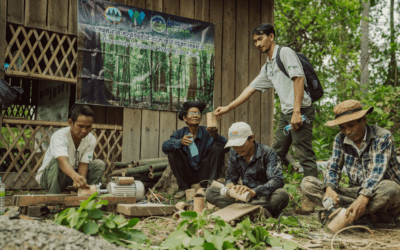Fires across the Amazon have been blazing for weeks, and with no end in sight, it is quickly becoming an international crisis of unseen proportions. While fires in the Amazon are not uncommon, this year has been especially destructive to one of the world’s most significant natural resources. Brazil’s National Institute for Space Research (INPE) reported over 70 thousand fires this year alone—an 84% increase from last year’s numbers.[1] While these fires have gained world-wide attention from politicians and environmental activists alike, many individuals are left wondering if there is any way to help. If you’re ready to do something about this tragedy, then we are here to assist you. Check out our five simple ways you can help minimize the impact of the 2019 Amazon fires.
What Is the Amazon Rainforest?
With more than 2 million square miles of jungle, the Amazon is the world’s largest tropical rainforest. Nearly 60% of the Amazon is located in Brazil, but it also extends into different areas of South America, including Venezuela, Ecuador, Bolivia, Guyana, Suriname, and French Guiana.[2]
Why Is the Amazon Rainforest Important?
The fires in the Amazon Rainforest are so devastating because of the variety of benefits this natural wonder offers the world. As one of the most biodiverse areas on the planet, the Amazon is home to nearly 10 million different species of animals, plants, and insects—some still waiting to be discovered.[3] The Amazon is also crucial for its ability to absorb carbon and produce oxygen. It absorbs over 2 billion tons of CO2 every year, helping improve the world’s air quality and lessen the effects of global warming.[4]
What Caused the Amazon Fires?
While there are several theories about the origins of these fires, the exact causes are still being debated. Brazil’s environmental minister, Ricardo Salles, has stated they are due to natural causes such as dry weather, heat, and lightning strikes. Others maintain the fires are the result of deforestation—extending farming and mining operations deeper into the forest.[5]
What Do These Fires Mean for Climate Change?
Regardless of how the fires started, the results are the same. For every tree that gets burned, the forest’s ability to absorb carbon is lessened, and at the same time, the fires are spewing even more carbon into the atmosphere. Some are worried the current conditions could also push areas of the Amazon to a tipping point that could transform the once-lush regions of the forest into a savannah. This kind of transformation could have far-reaching effects on climate change and dramatically increase carbon levels—effectively speeding up the warming of the planet.[6]
How Can You Help Minimize the Impact of the Amazon Fires?
With such high stakes, it is only natural that people everywhere want to help. While you may not be able to fight the fires yourself, there are still ways to encourage change and offset the damage.
1. Stay Informed
If you are reading this article, you are already off to a great start in making a difference. When it comes to this issue, and others that are shaping the climate change discussion, people need to stay informed. Knowing is half the battle, and we encourage all of our readers to keep up with this evolving story.
2. Speak Up
Unfortunately, this is not the first time the Amazon has been under attack. Since the opening of the Trans-Amazonian highway in 1972, civilization has been encroaching deeper and deeper into the rainforest. One thing that has kept the farmers and mining operations at bay is consistent public outcry and international pressures. You can see this occurring in real-time with the conversations surrounding the current fires. Politicians around the world are talking about economic sanctions on Brazil, and organizations are donating millions of dollars to help with the efforts. This support is due in part to pressure from the public. Hashtags such as #ActForTheAmazon have been trending on social media, and people are taking notice. If you are concerned about what is happening to the Amazon, then add your voice to the discussion. Talk with friends and family, and reach out to your political representatives to help fight for the issue.
3. Volunteer Your Time
While you may not be able to get on the ground in Brazil to help, there are still charities that could use your time and effort to do some good. Many trustworthy charities are working hard to help conserve the Amazon all year long, and there are opportunities to help. Below are just a few organizations you may consider.
- Amazon Conservation Association
- Amazon Conservation Team
- Amazon Watch
- Rainforest Foundation US
- Rainforest Trust
- Rainforest Action Network
4. Donate Your Money
Don’t have time to volunteer? Donating money to any of the organizations above can also help. Seeking out local organizations that focus on climate change or planting new trees could also help cancel out some of the damage that is currently happening. Before you donate, be sure to do your research on the organization and how they will use the funds you choose to give.
5. Reduce Your Environmental Impact
Every day, people make small and large choices that have an impact on the environment. From the car you drive to the food you eat, these choices over time will have a compound effect on the environment. However, there are some easy choices you can start to make today that will help reduce your environmental impact, including:
Recycling More
Recycling and using more sustainable products may help reduce the demand for goods produced from trees. Lowering the demand will, in turn, help lower the incentives of deforestation. If you have not done so already, take advantage of your local recycling programs, and look for products that use sustainable, recyclable materials.
Eating Less Beef
Brazil’s growing cattle industry is also driving deforestation.[7] Eating meat is a personal choice, but eating less may help reduce demand. Inexpensive beef, like the kind used in fast food chains, is often linked back to deforestation practices in Brazil and other places around the world.
Avoiding Palm Oil
Palm oil is made from trees found in the Amazon rainforest. Whether you know it or not, palm oil is a common ingredient in many of today’s foods.[8] Check the ingredients of the products you buy for palm oil, and whenever possible, check to see if that palm oil comes from sustainable sources. Otherwise, you may be unknowingly contributing to the cutting down of countless trees.
Purchasing Carbon Offsets
Another way you can begin to take personal responsibility for your environmental impact is by educating yourself on carbon offsets. It can be difficult, if not impossible, to live in a way that produces zero carbon emissions. Everything we do and buy has unforeseen carbon emissions attached to it all. Regularly purchasing carbon offsets can help mitigate your impact, and can help bring your carbon contribution down to zero.
Learn More About Your Carbon Footprint
At Terrapass, we’ve created a simple way for you to calculate your carbon footprint. You can use our free calculator to estimate your monthly carbon emissions and to discover more ways to decrease your carbon footprint. Just answer a few short questions, and we’ll do the rest of the work for you.
Are you looking for more ways to help the environment? Check out the Terrapass blog, and you’ll find more practical tips to help make the world a happier, healthier place.
Brought to you by terrapass.com
SOURCES:
www.worldwildlife.org/places/amazon
www.eurekalert.org/pub_releases/2013-10/fm-fms101413.php
advances.sciencemag.org/content/4/2/eaat2340.full.
www.ers.usda.gov/amber-waves/2019/july/brazil-once-again-becomes-the-world-s-largest-beef-exporter/
www.sciencedirect.com/science/article/pii/S0961953414002542
-
- .







